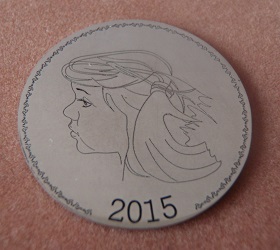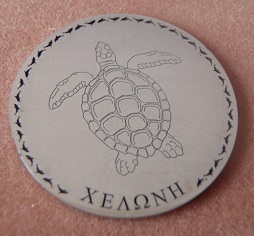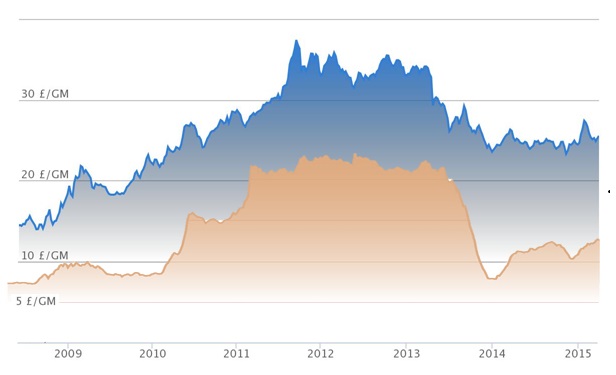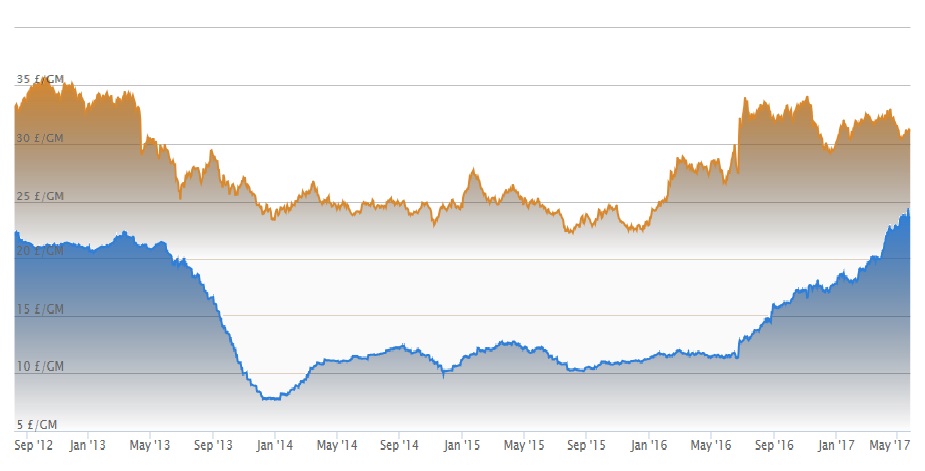Why print the first ever coin of pure Iridium
1. Introduction
The first two coins ever made of iridium were revealed on March 2015. Iridium is the second rarest metal on earth after osmium, and belongs in the class of precious metals. However, never before has a coin or piece of jewellery been made of this metal. The identical coins weigh 10.6g each with a diameter of 25.3mm. They are manufactured from 99.9% pure iridium. The obverse depicts a young girl’s head facing left, and the year 2015 as legend. The reverse side carries the shape of a sea turtle and the legend “CELWNH” meaning turtle in ancient Greek (see figure 1 below). The edges are plain. The fine and intricate designs were made using a precision laser device as nothing else can effectively produce designs on the material due to its unique nature.


Figure 1. Obverse and reverse of the coin, depicting the face of a girl with the print year inscription and a sea turtle with the coin subject inscription.
2. Rarity and history of the metal
Iridium belongs in the group of precious metals and for years now companies who deal in bulk over gold, platinum and silver have been tracking its exchange price. As the metal is the second densest in the world after osmium it is also the second most scarce. Dense and heavy elements like this have sunk to the core of the earth during its evolution, billions of years in the past. Hence today, we can only find small traces of it mixed in other stones and metal ores, commonly belonging to the precious metal group of platinides. Metals like platinum, palladium rhodium also belonging to the platinides group are already used in jewellery making today. However, iridium in nature is 40 times rarer than gold, 10 times rarer than platinum and 80 times rarer than silver. Indeed the extraction from mining on the earths solid crust is incredibly small while meteorite stones are often found to be richer in “parts per million” content of the element, a characteristic which often discriminates them from earth rocks during analysis. As a matter of fact, a handful of people have today seen and even held a single gram of pure iridium today.
The metal was recognised as a separate metal in 1803. Before that it was only being observed as a black and insoluble residue substance when dissolving large quantities of gold with “aqua regia” a powerful acid used to dissolve precious metals. To obtain the first melt of the metal, the world’s largest galvanic battery of the time had to be used. The metal was called iridium after the Greek goddess Iris, goddess of rainbow, due to the multitude of colours it gives when forming crystals.
3. Coins of other metals
Most other stable metallic elements have been used for monetary coinage, commemorative coins and medals. More common are copper, brass, iron, nickel, silver and gold. More unusual metals like lead, aluminium, tin, niobium, palladium, zinc have also been used for coin making historically and are still used by some countries and authorities. Metals like cobalt, manganese, titanium, chromium and tantalum were used for medals and fantasy coins. Not all metals are suited for coinage. A number of them are rather unstable in ambient temperature and humidity conditions. Calcium and sodium for example would readily react with water and sweat in ones hands. Gallium, regardless of its scarcity, would melt in temperatures above 35oC. A small selection is unsuitable due to health hazards like beryllium and arsenic which are highly toxic and plutonium, uranium, polonium and others are radioactive. Some metals are just unworkable as they are too brittle or too hard to strike coins in.
4. Impossible to strike
Iridium certainly falls in the ‘impossible to work with’ category. Mostly due to its density, the metal features Vickers hardness up to 1700 MPa and a tensile strength of 1200 MPa which is more than hardened chrome-vanadium steels, manganese steels or titanium. Consequently, any die would break on the blank without achieving a decent impression. Moreover, the very high melting point of iridium, at 2410oC and the preservation of its mechanical properties up to 2000oC, eliminate the mould casting approach also. In-fact, iridium is used for high performance ingot mould alloys, when the mould is required to maintain mechanical strength at very high temperatures. Only in recent years, the evolution in high beam quality short pulsed lasers has enabled effective processing of such metals, without significant loss of mass. The concentrated beam and high peak power pulses can achieve local temperatures of far more than 4150oC, instantly evaporating the irradiated material, yet leaving the surrounding material completely unaffected and at near ambient temperature. The first iridium coins described here were struck using such a laser beam. The high precision equipment setup used, costs more than $150 000. The process parameters used were being developed for months, without any previous reference of laser processing of iridium. The scarcity and high cost of the element has prevented universities and research institutes from investigating laser processing of the material. Many years of experience in developing laser systems and laser process parameters for advanced industrial materials were necessary to identify processing parameters. A laser engineer in Crawley, UK, had to develop the processing parameters step by step while avoiding waste of the highly expensive material. The result was a successful impression with image reproduction precision of 30 millionths of a meter and no thermal distortion or heat affected areas.
The impressions were chosen to represent typical coin attributes, usually a face, the date of manufacture, a shape or event and a name for the coin. The subject, and effectively the name, of the coin was chosen to be the Chelone, after one of the oldest coin specimens that was widely accepted as payment in the archaic world, the homonym coin from Aegina, Greece. The legend is thus written in ancient Greek under a shape of a sea turtle. The surrounding embellishment is made of dolphin designs as another reference to ancient coins from Olbia in Thrace and other stater coins of the same time. The other side carries the face of a little girl in profil and the date of manufacture embossed under the head. The embellishment is ribbons tied in chain-linked loops.
5. Longevity
Once struck however, iridium forms the perfect metal for coinage, medals and memorabilia. It features the three most important properties of value retention. Iridium has the highest corrosion and oxidation resistance than any other element known. Gold, as well as the platinides feature very high resistance to corrosion, even against acids. They can only be dissolved with very strong acids such as agua regia, based in nitric acid. Iridium, from its early days is known as the substance that precipitates after treatment with agua regia. The pure metal will withstand attack from any acid or base at ambient temperatures and from most at elevated temperatures also. For this reason, the international standard for the unit of 1kg at the International Bureau of Weights and Measures in Paris, remains the only standard that remains defined by a material item as the prototype reference until today.
One of the properties that maintain the high value of gold as coinage or jewellery is its resistivity to oxidation and corrosion. Today, gold coins from antiquity are preserved well for the last 2500 years, baring only mechanical wear. The next most important property of iridium is its very high Mohs hardness rating of the class of precious stones such as emerald, quartz, turquoise and others. As the Mohs scale denotes scratch and mechanical wear resistance, the high rating ensures that the impressions will remain on the coins for thousands of years. The final property of importance is the high melting point and mechanical performance at high temperatures. During process parameter development with a 1 gram sample, the sample temperature was raised to 1800oC and no loss of printed impressions quality was observed. Artefacts made from iridium can be expected to survive and maintain struck impression for thousands of years even under conditions of volcano eruptions, meteor crashes, saltwater and acid exposure and possibly extra-terrestrial conditions.
6. Value and history of gold and silver
Although iridium belongs to the precious metals group and is much rarer than gold and platinum, it is not commonly known to the wide public for its high price. But why were metals like silver and gold got established globally as high value metals? They were both known and widely used since antiquity. In places like Persia, gold was a commonality used in coinage, jewellery and other household utensils. Metals such as copper and iron were also known and used in battle equipment and construction due to their higher strength and hardness against gold and silver. Their corrosion susceptibility of iron and copper when in contact with water and human skin though made them of low interest for use in jewellery and household utensils. Items made of such metals lose their lustre in days, while they undergo heavy corrosion when in frequent contact with water, salts and seawater. Bronze on the other hand features good strength and moderate resistance to corrosion.
Silver was recognised for two very attractive properties in jewellery, its highest reflectivity and shine than other metals when polished and the ability to be easily restored. Silver does form the yellow/black tarnish we are all acquainted with, but will not corrode and loose shape when frequently worn, handled and brought in contact with water. Its restoration was known and possible since antiquity also. Hence coins and other items made of silver have persevered in time when protected against mechanical wear. Coins need to be handled in exchanges and carried in pockets under all weather conditions, therefore the metal is an excellent choice for preserving the depictions and consequently, recognisable value given to them by the printing establishment. As a result, silver gained its position as the most typical unit of exchange until early 20th century. In most languages their word for silver is synonym to money or coins.
Pure gold is very soft and very susceptible to mechanical wear. Nonetheless, it preserves its characteristic yellow metallic lustre regardless of exposure to water, seawater and most acids and chemicals. Use in jewellery and expensive home utensils has for this reason, been highly appealing to investors. The combination of gold as a material that can be formed into a ring due to its malleability, but maintain its shine, and a hard rock like ruby or diamond, has been established as the most typical piece of jewellery with value in history, for these reasons. In coinage, when protected from mechanical wear, it is expected to retain its depictions and hence recognisable value indefinitely. Indeed, some very old coins like The Darics have been maintained for more than 2 millennia with clearly recognisable shapes and designs. The investment in gold coinage was for this reason established as the most secure deposit of value regardless of nation, time or printing authority. Metals like platinum and palladium were rarer and more difficult to separate and work with in past centuries. The value of such metals was recognised in more recent years, due to their rarity and resistance to corrosion.
7. Today’s economy
Since the economic crisis broke out in 2008, gold and silver prices started rising to 5 times the starting value. This typical market reaction to insecurity has taken place in all previously recorded global crises and wars. Other precious metals tracking gold and silver in value, like platinum, palladium and rhodium have followed the same trend. The same was true for iridium. Iridium has smaller variations in market value because of its scarcity and low public awareness.
It is interesting to observe that the stock traded value of iridium today does not match the very high sale price of actual specimens. The reason for this is that the stock traded value does not represent the metal’s scarcity and resistance to corrosion or wear when compared with gold, only the present rate of absorption in the market. Indeed its value is around half that of gold and platinum, while its scarcity is 7 times greater. Low knowledge of its existence by the public and nearly zero availability in the market keep trading volumes and interest in the metal itself supressed at this point in time.
By observing the stock market trend of the metal in Figure 2 below, one can observe the slow rise from 2008 onwards. Some sharp price rise events occur after 2010 and 2011 due to utilisation of improved technologies in the mining and extraction of iridium from mined ore, combined with a strong market for secure deposits as evident on gold’s market trend. In 2013, the annual production globally triples, dictating a fall in price due to higher market availability, though still, much lower than any other metal. On February 2014, the release of the first item to be made available to the open public, a razor, instigates a price rise to nearly double the amount, at £12/g. The price of the metal in the stock market has been sustained at that level for 2 years. In 2016, the price of iridium started rising after The UK’s referendum to exit the European Union. The price plateaued towards the end of 2016. In January 2017, the price rise slope increased again (figure 3) due to the announcement of regular manufacturing of jewellery by Smithson Tennant, a company named after the discoverer of the element. The price of the metal is only expected to continue rising as demand grows with the gain in publicity.

Figure 2. Comparison of stock market value trend between gold and iridium.
Graphical data curtesy of Cookson Precious Metals Ltd (March 2015, http://www.cooksongold.com/).

Figure 3. Stock market value evolution of iridium aginst gold.
Graphical data curtesy of Cookson Precious Metals Ltd (May 2017, http://www.cooksongold.com/).
8. Market availability of the metal
Market availability of the actual metal is so small that it is impossible for the everyday person to own a single item made of iridium. The only item made of high purity iridium and marketed to the open public until 2016 was a razor made by Zaffiro and attributed a value of 100 thousand US dollars. Iridium plating is used in good quality fountain pens, where a thin coating of approximately 10 millionths of a meter thick is applied on the nib, to protect it from abrasion wear. The coating may be pure iridium or a mix of the platinum group metals giving a hard enough coating. Occasionally goldsmiths create platinum-iridium pieces with an alloy containing 10% iridium. Indicative value for a platinum iridium ring is $1000 USD. Iridium coated jewellery items have also been created on occasion. In 2017, the option for purchasing pure iridium in the open market emerged in the form of simple shape wedding bands with prices between $2000 and $4000 USD. Nearly half of the price represents the expense of the manufacturing process using high temperature, high pressure kilns and not just the material cost. Small samples weighing around 1g are often found in science kits, to represent the element for students to study visually. The kits contain other rare and expensive metals and elements that are considered safe to handle. Finally, some companies that commercialise mining products offer pure iridium in powder form, ready for metallurgists to process. The powder is marketed at more than 3 times the nominal stock exchange value of the metal, when sold in quantities weighing less than 1kg.
9. The future
The two coins were not manufactured as banking bullions but as an artistic statement that iridium is a metal with suitable properties for constructing medallions, memorabilia and very high value coinage. The higher resistance in corrosion, strength and hardness, ensure maintenance of printed features for nearly eternity and thus sustenance of deposited value and investment. The coins would be able to survive a volcanic eruption, attack from a steel knife and possibly a bullet, an earthquake disaster or car crash and any other abuse, without losing their form and printed features. The rarity and difficulty of processing, demonstrated by the fact that these first coins could only be constructed with the use of high-tech methods such as lasers, render them high value items straight away. Coins and items made of pure iridium are counterfeit proof as the material density (which is double that of lead and higher than platinum for example) cannot be replicated by any other material known to man. Consequently, plated or coated counterfeits can instantly be recognised by weighing.
Production volume of iridium has increased since 2012 from 3 metric tons annually to just about 10 tons. The metal is now becoming available for both value storage and other commercial uses. The hardness, high tensile strength and high melting point make it the ideal metal for technically challenging applications. A spacecraft who’s external shell is made of iridium for example would be nearly indestructible and would have the highest chances of flying safely close to the sun or through an asteroid zone without exterior damages. Today, USA, Canada and China produce the largest quantities of these metals. China as the largest exporter of rare metals including iridium has recently stated interest in future mining operations on the moon and possibly even mars in order to maintain its market dominance on such rare metals (One Step from Earth, R. Corfield, 5 Feb 2015, Physics World). The metal is found in greater quantities in celestial bodies like asteroids, arid planets and moons. It is thus likely that in the years to come, man will learn how to exploit better the properties of the material and the market will start seeking sources of iridium as the key material of the future, together with future fuel resources such as tritium. Iridium may naturally advance to become the main market reference metal for exchanges and consequently high value currency.